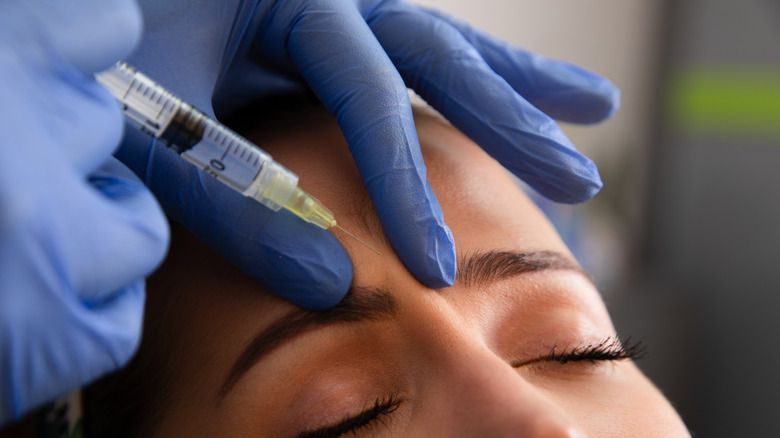The Types Of Facial Fillers That Can And Can't Be Dissolved
Among all the big trends that have dominated the beauty world these past years, few have been quite as omnipresent as facial fillers. Unlike Botox, which targets the muscles, dermal fillers help to literally fill any areas with wrinkles or folds on the skin. Many people choose to get filler for smoother skin, whereas others just want a plumper look in a certain part of their face. "They help with lines present at rest — like nasolabial folds or marionette lines — and help restore structure and volume to the cheeks, mid-face, or lips,"" explains Dr. Hibler to Allure. Whatever the reason, there are heaps of fillers to choose from that aim to target various areas of the skin.
Too much filler, however, can lead to filler migration and a generally swollen, puffy appearance (also sometimes known as pillow face), something nobody wants to end up with. The good news is some fillers can be removed. Unfortunately, others can't, and that's where things get tricky.
Fillers with different bases have different stipulations
Speaking to The Zoe Report, board-certified dermatologist Dr. Ava Shamban gave the lowdown on which fillers can be dissolved. Firstly, fillers that are hyaluronic acid based can most likely be dissolved. Common fillers that are hyaluronic acid-based include Juvederm, Juvederm Voluma, Restylane, Restylane Lift, and Belotero.
"Our natural body white blood cells secrete hyaluronidase, which is part of our immune response that causes filler to dissolve," Shamban revealed. The good news is that, if you don't want to wait for your body to do its thing, extra hyaluronidase can be injected in the area of your filler in order. This added enzyme will then accelerate the process of your filler, causing it to break down faster.
The bad news is that, depending on the amount of filler you have, it can take up to ten sessions to fully dissolve it all. As well as keeping in mind that the process isn't usually a quick one, you should know that dissolving your filler also comes with potential setbacks. Aesthetics doctor Dr. Paul Charlson told Dazed that there is a one in 100 chance of being allergic to hyaluronidase and experiencing adverse effects such as pain, wrinkly lips, and a blurred lip line, so you should always get a patch test done first for safety.
Always do intensive research before any procedure
Fillers that do not feature a hyaluronic acid base will achieve different results. Common bases for these alternate fillers are calcium hydroxylapatite, poly-L-lactic acid, and polymethyl methacrylate. Two of the most popular non-HA filler options are Sculptra and Radiesse. These fillers reduce wrinkles by stimulating collagen production.
However, fillers with the above base cannot be dissolved using the same hyaluronidase method. Per The Zoe Report, aesthetics doctor Dr. Rahi Sarbaziha advised that they "can be manipulated to some extent after injection, but complete dissolution is challenging." This means that if you do experience filler fatigue symptoms from using the above fillers, it will be a lot more difficult for you to get rid of it. Moreover, as board-certified plastic surgeon Dr. David Shafer revealed to TZR, the odds of dissolving filler without a hyaluronic base are extremely low — in his words, "close to 0%."
Dissolving filler can only be done in some cases, and as with any procedure, there are risks. You should never jump into something unless you are 100% sure that you'll get the results you're looking for.


